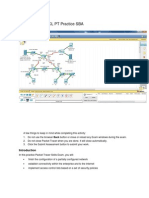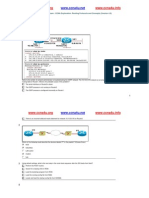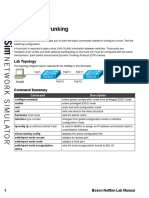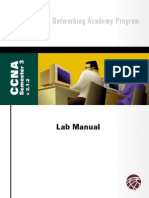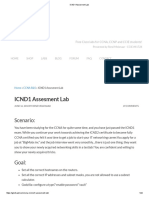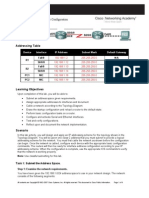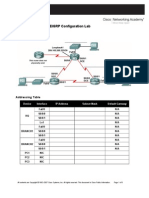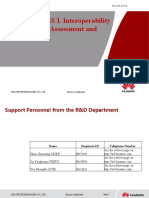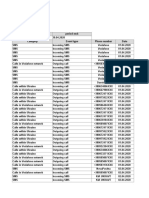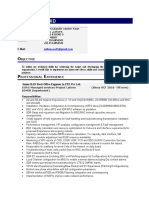CCNA Semester2
CCNA 3.1
Lab Topology
�Semester 2
�Lab 2.1 Console connection
Observe real routers and routers interfaces
Establish console connection
�Lab 2.2 CLI and show commands
Stand-alone routers
�Lab 2.3 Basic router configuration
R1
R2
R3
R4
R5
R6
S1
201.10.11.1/24
S0
201.10.11.2/24
S0/0
199.6.13.2/24
S0/1
192.168.3.1/24
S0
192.168.3.2/24
S0
34.10.120.2/16
N/A
S1
199.6.13.1/24
S1/0
204.204.7.1/24
S0/0
204.204.7.2/24
S1
34.10.120.1/16
NA
E0
172.16.11.1/16
E0
172.18.12.1/24
F0/0
172.16.11.2/16
F0/0
172.17.13.1/16
E0
172.18.12.2/24
E0
172.17.13.2/16
�Lab 2.4 - CDP
R1
R2
R3
R4
R5
R6
S0
10.1.0.1/16
S0
10.2.0.1/16
S0/0
10.3.0.2/16
S0/0
10.4.0.1/16
S1
10.6.0.2/16
S0
10.6.0.1/16
S1
10.2.0.2/16
S1
10.3.0.2/16
S1/0
10.4.0.2/16
S1/1
10.5.0.2/16
S2
10.5.0.1/16
S1
10.1.0.2/16
E0
10.7.0.2/16
NA
F0/0
10.7.0.1/16
F0/0
10.8.0.1/16
NA
E0
10.8.0.2/16
�Lab 2.5 Recover password and IOS
Stand-alone routers
�Lab 2.6 Static route
R1
R2
R3
R4
R5
R6
S1
201.10.11.1/24
S0
201.10.11.2/24
S0/0
199.6.13.2/24
S0/1
192.168.3.1/24
S0
192.168.3.2/24
S0
34.10.120.2/16
N/A
S1
199.6.13.1/24
S1/0
204.204.7.1/24
S0/0
204.204.7.2/24
S1
34.10.120.1/16
NA
E0
172.16.11.1/16
E0
172.18.12.1/24
F0/0
172.16.11.2/16
F0/0
172.17.13.1/16
E0
172.18.12.2/24
E0
172.17.13.2/16
�Lab Lab 2.7A - RIP 2.6 Static route
R1
R2
R3
R4
R5
R6
S1
201.10.11.1/24
S0
201.10.11.2/24
S0/0
199.6.13.2/24
S0/1
192.168.3.1/24
S0
192.168.3.2/24
S0
34.10.120.2/16
N/A
S1
199.6.13.1/24
S1/0
204.204.7.1/24
S0/0
204.204.7.2/24
S1
34.10.120.1/16
NA
E0
172.16.11.1/16
E0
172.18.12.1/24
F0/0
172.16.11.2/16
F0/0
172.17.13.1/16
E0
172.18.12.2/24
E0
172.17.13.2/16
�Lab 2.7B - IGRP
�Lab 2.9 Default route and troubleshooting
�Lab 2.11A Standard ACL (offline)
�Lab 2.11B - Extended ACL (offline)
RA
172.16.3.100
�Lab 2.11C - ACL Challenge (offline)
Outer-network cant ping into innernetwork
Internet
E0
Do not allow outer-network to access
inner-network except web service in
Web Server(.66).
Traffic between Net1 and Net3 is not
allowed
Other networks can only access web
service in Web Server
Packets between PC1(.48) and PC3
(.80) are only allowed if routed across
the direct serial link
S0
R_1
S1
Net3
.96
S1
E1
R_2
192.169.10.0/2
4
S0
S0
R_3
E0
E0
PC1
Telnet to routers only from PC1
Net1
All other kind of traffic is allowed
.32
PC2
S1
PC3
Net2
.64
Web
�Lab 2.0A Open Lab for 6 students
Given the IP address range: 220.10.5.0
Assign IP address to all hosts in the network
-Serial connection using clock rate 64k and
HDLC encapsulation
-Config routing using IGRP with AS number
of 90 for R2, R3, R4, R5
-R1 and R6 use default route only
-Be able to use name to access other routers
-Using meaningful banner and description
-All access must be authenticated
-Capture config using tftp-server or hyper
terminal
-Do not allow R1 and R6 Ethernet network
to telnet to R3
-Only allow WS_A and WS_B to access R4
website
�Lab 2.0B Open Lab for 5 students
Given the IP address range: 190.6.0.0/16
-Assign IP address to all host in the
network
-Serial connection using clock rate 64k
and HDLC encapsulation
-Using meaningful banner and description
-All access must be authenticated
-Config routing using IGRP with AS
number of 200 for Lab B, C, D
-Lab A and Lab E use default route only
-Be able to telnet to and config all routers
using name
-Capture config using tftp-server or hyper
terminal
-Only allow Lab_C to telnet to LAB_B
-Do not allow any host except WS_A and
WS_B access LAB_C website
�Semester 3
�Lab 3.1 VLSM and RIPv2
Use VLSM to create subnet address for each
network with the requirement of IP:
Each Ethernet network in Site A requires 30 IPs
Each Ethernet network in Site B requires 10 Ips
Use RIP v2 for routing protocol
�Lab 3.2 - OSPF
199.6.3.0/24
ProcessID: 5
DR:Branch1 & Site2
Key:newospf
Hello: 17s
Dead: 49s
Internet:Branch1
Loopback
�Lab 3.3 - EIGRP
�Lab 3.6 Basic switch configuration
Stand-alone switches
�Lab 3.7 - STP
�Lab 3.8 - VLAN
�Lab 3.9A: VLAN & VTP
Configure VTP domain: CCNA, password: class, version 2.
VLANs: Associate, Professional, Specialist
Trunk ports: Server: f0/1, Client: f0/2
Ports ->
Default
Associate
Professional
Specialist
Server
2 3, 6
4,5,8 12
7,13 19
20 24
Client
1,3 9
10 15
15 18, 20
19, 21 24
�Lab 3.9B VLAN & InterVLAN
IP range: 172.20.0.0/16
Vlan Default (port 1 5) needs 5 IPs
Vlan Sales (port 6 10) needs 100 IPs
Vlan Engineer (port 11 15) needs 50 IPs
Vlan Marketing (port 16 23) needs 100 IPs
�Lab 3.0A Open Lab for 6 students
Each Ethernet network requires 30 IPs
Configure names, passwords, descriptions and banners for routers
SW3 is Server, SW2 is Client, VTP domain Open, password Lab with 4 Vlan
named: Default, Sale, Marketing, Accouting. Create 3 Vlan named: Default,
Remote, Small on SW1. Set IPs for SWes.
Inter-VLAN routing for all 4 VLANs on Router E2 and 3 Vlan on Router Gate.
Redistribute routes between the 2 area with default metric
Only nodes in VLAN Remote are allowed to telnet to O1 and O2
Do not allow any SW1s VLAN to access E2 by web
Do not allow ftp and tftp traffic between 2 areas.
�Semester 4
�Lab 4.1 NAT/PAT & DHCP
�Lab4.2 Topology
�Lab4.3 Topology
�Lab 4.4 ISDN Dial-on-Demand routing
Configure dial-on-demand routing between 2 sites.
�Lab 4.6A Frame Relay
1.
2.
PVC(21-42) and PVC(32-41) belong to 1 subnet (partial-mesh)
IP address is 192.168.1.0/24 . Each Loopback interface requires 30
IPs. Rouing protocol is EIGRP with AS 100
�Lab 4.6B Frame Relay Full mesh
�Lab 4.0 Open Lab

